
Calypso is a genus of orchids containing one species, Calypso bulbosa, known as the calypso orchid, fairy slipper or Venus's slipper. It is a perennial member of the orchid family found in undisturbed northern and montane forests. It has a small pink, purple, pinkish-purple, or red flower accented with a white lip, darker purple spottings, and yellow beard. The genus Calypso takes its name from the Greek signifying concealment, as they tend to favor sheltered areas on conifer forest floors. The specific epithet, bulbosa, refers to the bulb-like corms.
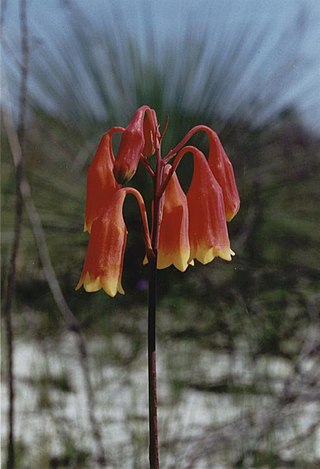
Blandfordia grandiflora, commonly known as Christmas bells, is a flowering plant endemic to eastern Australia. It is a tufted perennial herb with narrow, channelled, linear leaves and between two and twenty large, drooping, bell-shaped flowers. The flowers are red with yellow tips, or sometimes entirely yellow. It is one of four species of Blandfordia known as Christmas bells, this one growing on the coast and nearby ranges between Sydney in New South Wales and Fraser Island in Queensland.

Bulbine is a genus of plants in the family Asphodelaceae and subfamily Asphodeloideae, named for the bulb-shaped tuber of many species. It was formerly placed in the Liliaceae. It is found chiefly in Southern Africa, with a few species extending into tropical Africa and a few others in Australia and Yemen.
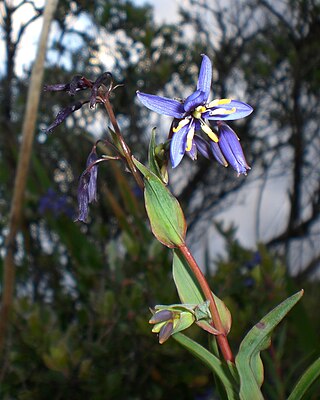
Stypandra glauca, commonly known as the nodding blue lily, is a flowering plant in the family Asphodelaceae. It is a rhizomatous perennial plant with blue lily-like flowers with yellow stamens. It is widespread across southern areas of Australia.

Dianella revoluta, commonly known as blueberry lily, blue flax-lily, or black-anther flax-lily, a species of flowering plant in the family Asphodelaceae and is endemic to, and widespread in Australia. It is a tufted, perennial herb with grass-like leaves and up to nine blue or violet flowers with six tepals, and stamens with bright yellow filaments and pale brown to almost black anthers.

Conostylis aculeata, commonly known as prickly conostylis, is a flowering, tufted perennial plant in the family Haemodoraceae. It has flat leaves and yellow, hairy, tubular flowers. It is endemic to the south-west of Western Australia.

Teucrium corymbosum, commonly known as forest germander, is a species of flowering plant in the family Lamiaceae and is native to Australia and New Guinea. It is a perennial herb or subshrub densely covered with glands and with narrow egg-shaped leaves usually with toothed edges, and groups of mostly up to ten white flowers.
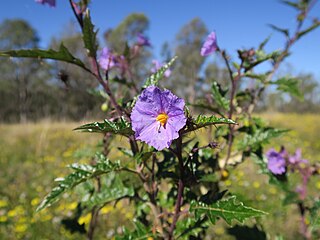
Solanum cinereum, commonly known as Narrawa burr, is a species of flowering plant in the family Solanaceae. It has dark green, spiny leaves and purple flowers and grows in open woodland in south eastern Australia.

Patersonia sericea, commonly known as purple flag or silky purple-flag is a species of plant in the iris family Iridaceae and is endemic to eastern Australia. It is a densely-tufted perennial herb with linear, sword-shaped leaves, broadly egg-shaped, bluish-violet tepals and an oval capsule.
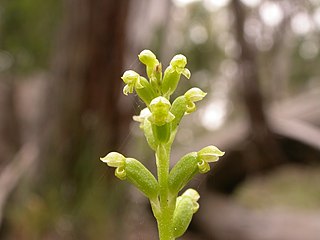
Microtis parviflora, commonly known as the slender onion-orchid, is a species of orchid which is native to Australia and New Zealand. It occurs in all states of Australia but is not known from the Northern Territory and may not occur in Western Australia. As with others in the genus, it has a single erect, smooth, tubular leaf and up to eighty flowers on an erect flower spike.
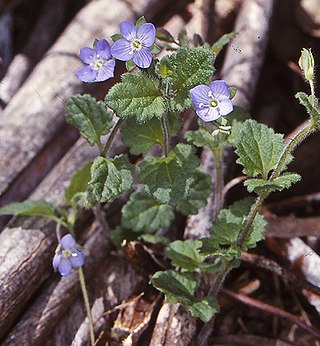
Veronica calycina, commonly known as hairy speedwell or cup speedwell, is a flowering plant in the family Plantaginaceae. It is a trailing perennial with dark green leaves, purple-blue flowers and is endemic to Australia.
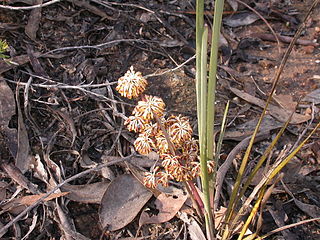
Lomandra multiflora, also commonly known as many-flowered mat rush, mat rush and many flowered mat-lily, is a perennial, rhizomatous herb found in Australia and Papua New Guinea. The mat rush is distributed widely in the region and common within its preferred growing conditions. Its conservation status is considered not to be of concern and risk.

Dianella longifolia, commonly known as blueberry lily, pale flax lily or smooth flax lily, or blue flax-lily, is a species of flowering plant in the family Asphodelaceae and is endemic to non-arid areas of Australia. It is a tufted, rhizomatous, perennial herb with grass-like leaves, pale blue, white or greenish flowers that have pale yellow anthers, and shiny, pale blue berries.

Tricoryne elatior is a species of flowering plant in the family Asphodelaceae, native to Australia, and found in all its states and territories.

Goodenia coerulea is a species of flowering plant in the family Goodeniaceae and is endemic to the south-west of Western Australia. It is an erect, perennial shrub or biennial herb shrub with linear leaves at the base of the plant, sometimes with a few teeth on the edges, racemes of blue flowers and oval fruit.

Goodenia rotundifolia is a species of flowering plant in the family Goodeniaceae and is endemic to eastern Australia. It is a prostrate to erect perennial herb with more or less round, toothed leaves and racemes of yellow flowers.

Patersonia glabrata, commonly known as leafy purple-flag, or bugulbi in the Cadigal language, is a species of flowering plant in the family Iridaceae and is endemic to eastern Australia. It is a perennial herb or subshrub with linear leaves and pale violet flowers.

Johnsonia lupulina, common known as hooded lily, is a plant in the family Asphodelaceae and is endemic to the south-west of Western Australia. It is a rhizomatous, tufted, clump-forming perennial with creamy-white flowers.
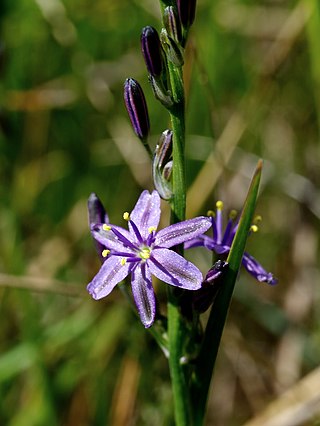
Caesia calliantha, commonly known as the blue grass lily or blue star lily, is a species of herbaceous flowering plant. It is a member of the Asphodelaceae family, subfamily Hemerocallidoideae, native to Australia found predominantly along the East coast in Victoria, New South Wales, South Australia and Tasmania.

Goodenia perfoliata is a species of flowering plant in the family Goodeniaceae and is endemic to a small area of New South Wales. It is a mostly glabrous, perennial herb with erect flowering stems, lance-shaped leaves with sometimes deeply-toothed edges, and yellow flowers with bracteoles joined to form a disc-like funnel.




















